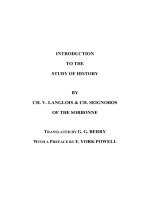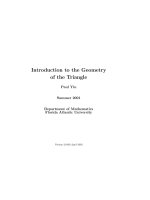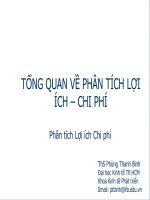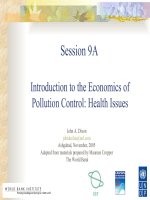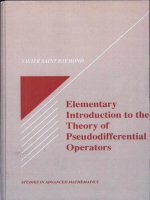Introduction to the Economics of Pollution Control: Health Issues
Bạn đang xem bản rút gọn của tài liệu. Xem và tải ngay bản đầy đủ của tài liệu tại đây (239.3 KB, 18 trang )
Session 9A
Introduction to the Economics of
Pollution Control: Health Issues
John A. Dixon
Ashgabad, November, 2005
Adapted from materials prepared by Maureen Cropper
The World Bank
GEF
What Questions Can Economic
Valuation/BCA Help Answer?
How stringent should environmental standards be for
Air quality?
Surface water quality?
Drinking water quality?
What about POPs?
Any other pollutant?
Caspian EVE 2005/UNDP and WBI
John A. Dixon, Economics of Pollution Control
GEF
Benefits and Costs of Pollution
Control
Four categories of benefits could be examined:
Human health (the focus here)
Visibility (amenity values)
Ecological Effects (and ecosystem
services)
Agricultural Benefits (change in
production)
Caspian EVE 2005/UNDP and WBI
John A. Dixon, Economics of Pollution Control
GEF
Valuing Environmental Health Effects
Damage Function Approach
Value of number of cases of illness/death avoided =
Number of Cases Avoided * Value per Case
Value per Case Avoided should reflect individual’s
willingness to pay (WTP) to avoid illness or risk of
death
Human Capital/Cost of Illness Approach, which
focuses on lost productivity, medical costs, generally
serves as a lower bound to WTP
Caspian EVE 2005/UNDP and WBI
John A. Dixon, Economics of Pollution Control
GEF
The numbers can be large! For example, in
2010 the Monetized Benefits from the US
Clean Air Act are estimated as follows:
Cost
Mortality
Chronic Bronchitis
Other Morbidity
Productivity
Visibility
Agriculture
0
Caspian EVE 2005/UNDP and WBI
John A. Dixon, Economics of Pollution Control
20
40
60
80
Billions of 1990 US$
GEF
100
120
Steps in Calculating Health Benefits for
Air or Water Quality Improvements
Predict change in emissions of criteria pollutants associated
with air/ water quality regulations
Translate changes in emissions into population-weighted
changes in ambient exposures
Calculate associated changes in health outcomes
Reduced premature mortality
Reduced hospital admissions
Fewer cases of chronic bronchitis or diarrhea
Assign a dollar value to cases of illness, mortality avoided
Caspian EVE 2005/UNDP and WBI
John A. Dixon, Economics of Pollution Control
GEF
Air Pollution Example:
Studies of the Health Impacts
Examine effects of acute air pollution exposure on
Premature death
Hospital admissions for heart, lung disease
Emergency room visits for heart, lung disease
Work-loss days
Examine effects of chronic exposure on
Premature death
Chronic bronchitis
Caspian EVE 2005/UNDP and WBI
John A. Dixon, Economics of Pollution Control
GEF
Interpretation of Dose-Response
Function (or DRR)
Dose-response function relates health effects to air
pollution concentrations and other factors affecting health
Slope of dose-response function measures the percentage
change in the health outcome for a one unit change in
PM10
For example, a 10 microgram reduction in PM10 reduces
deaths by about 4% in studies of the impact of long-term
exposure to air pollution on deaths
Caspian EVE 2005/UNDP and WBI
John A. Dixon, Economics of Pollution Control
GEF
Projected Reductions in Illness due to the US
Clean Air Act, Titles I - V
Health Endpoint
Mortality
Age 30+
Chronic Illness
Chronic bronchitis
Chronic asthma
Hospitalization
Respiratory admissions
Cardiovascular admissions
Asthma-related emergency room visits
Minor Illness
Avoided respiratory illnesses and
symptom-days, asthma attacks, work
loss days, etc.
Pollutant
2010 Mean reduction
PM et al
23,000
PM
Ozone
20,000
7,200
PM, CO, NO2, SO2, Ozone
PM, Ozone
22,000
42,000
4,800
PM, NO2, SO2, Ozone
Millions of cases/incidence
PM, CO, NO2, SO2, Ozone
Caspian EVE 2005/UNDP and WBI
John A. Dixon, Economics of Pollution Control
GEF
Valuing Environmental Health Effects
The Damage Function Approach:
Value of number of cases of illness/death avoided = Number of Cases
Avoided * Value per Case
Value per Case Avoided should reflect individual’s willingness to
pay (WTP) to avoid illness or risk of death
Human Capital/Cost of Illness Approach, which focuses on lost
productivity, medical costs, generally serves as a lower bound to
WTP
Caspian EVE 2005/UNDP and WBI
John A. Dixon, Economics of Pollution Control
GEF
Valuing Risks to Life: What Is to Be
Valued?
Epidemiologic studies predict number of deaths
avoided
Treat these as equivalent to reducing risk of death
for each person in the exposed population
Risk reduction per person =
(Number of deaths avoided)/(Size of exposed
population)
Caspian EVE 2005/UNDP and WBI
John A. Dixon, Economics of Pollution Control
GEF
Key Concepts
Concept of a Statistical Life
Reducing risk of death by 1 in 10,000 for each
of 10,000 people saves one statistical life
Value of a Statistical Life (VSL)
If each of the 10,000 people is willing to pay
$500 for the 1 in 10,000 risk reduction
the Value of a Statistical Life is = 10,000 x
$500 = $5,000,000
Caspian EVE 2005/UNDP and WBI
John A. Dixon, Economics of Pollution Control
GEF
How to Measure WTP for a
Reduction in Risk of Death?
Labor Market Studies
Contingent Valuation Studies
Use compensating wage differentials to value risks
of death
Ask people directly what they would pay for a
change in risk of death
Averting Behavior Studies
Use data on seatbelt use, purchase of smoke detectors,
switch to low-tar cigarettes
Caspian EVE 2005/UNDP and WBI
John A. Dixon, Economics of Pollution Control
GEF
Empirical Estimates of Value of a
Statistical Life (VSL) in the US
Value of Statistical Life estimates range between $ 1 - 10
million (1990 USD); USEPA’s preferred estimate is $4.8M
(1990 USD)
Problems:
Average age of worker is 40—older than average age
of person whose life is extended by an environmental
program
Estimates of VSL from Averting Behavior Studies
almost one order of magnitude lower than in Labor
Market Studies
Caspian EVE 2005/UNDP and WBI
John A. Dixon, Economics of Pollution Control
GEF
Valuing Reductions in Morbidity (sickness)
Private WTP for a reduction in risk of illness should
reflect:
Value of lost work time
Value of lost leisure time
Value of expenditures to treat illness
Value of expenditures to avoid illness
Discomfort (pain) of illness
Value to Society of the Risk Reduction = Individual’s WTP
plus reduction in costs borne by society
Cost of Illness = Value of lost work time + Value of medical
expenditures
Caspian EVE 2005/UNDP and WBI
John A. Dixon, Economics of Pollution Control
GEF
Approaches to Valuing Morbidity
Ask directly WTP to avoid illness or risk of
illness
Look at rate of substitution of one risk for
another (Risk-Risk Tradeoffs)
Use Cost of Illness estimates as a lower
bound to WTP
Caspian EVE 2005/UNDP and WBI
John A. Dixon, Economics of Pollution Control
GEF
Health Effects in the US:
Valuation per health outcome (1990 $)
Endpoint
Pollutant
Valuation (mean est.)
Mortality
PM10
4,800,000
Per case
Chronic Bronchitis
PM10
260,000
Per case
Chronic Asthma
O3
25,000
Per case
Hospital Admissions
All Respiratory
SO2, NO2, PM10,O3
6,900
Per case
All Cardiovascular
SO2, NO2, CO, PM10,O3
9,500
Per case
194
Per case
Emergency Room Visits for Asthma
PM10,O3
Respiratory Illness and Symptoms
Acute Bronchitis
PM10
45
Per case
Asthma Attack or Moderate or Worse Asthma Day
PM10,O3
32
Per case
Acute Respiratory Symptoms
SO2, NO2, PM10,O3
18
Per case
Upper Respiratory Symptoms
PM10
19
Per case
Lower Respiratory Symptoms
PM10
12
Per case
Shortness of Breath, Chest Tightness, or Wheeze
PM10, SO2
5.3
Per day
PM10
83
Per day
PM10,O3
38
Per day
Work Loss Days
Mild Restricted
Activity Days
Caspian
EVE 2005/UNDP
and WBI
John A. Dixon, Economics of Pollution Control
GEF
Valuing Morbidity and Mortality in
the Caspian region
Persian Gulf Environmental Damages (air pollution
from burning oil wells)
VSL calculations from Iran
Other examples
And don’t forget the other types of values:
Amenities
Ecosystem effects
Agricultural/ fisheries production
Caspian EVE 2005/UNDP and WBI
John A. Dixon, Economics of Pollution Control
GEF


